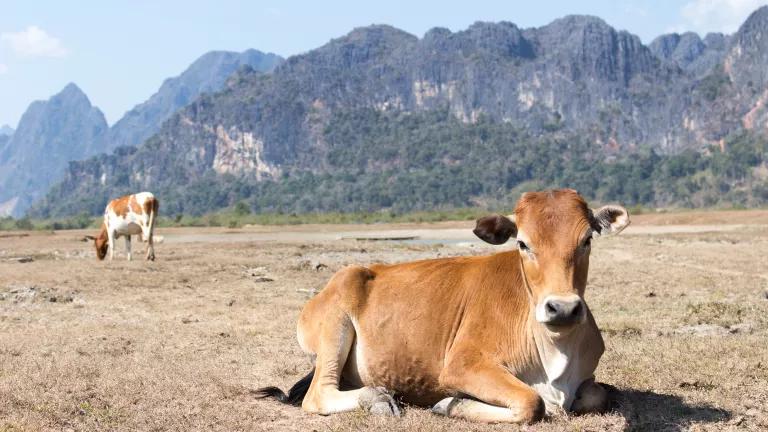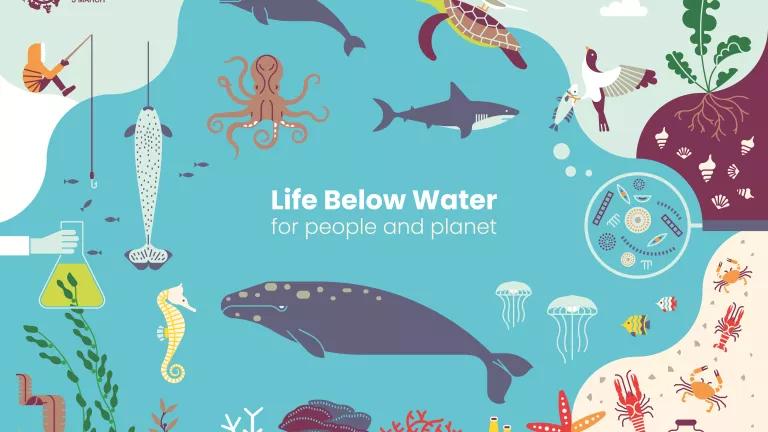IPCC: Food Systems Adaptation Is Critical
We need sweeping climate action—and we cannot afford to overlook our food system in that effort. With powerful legislation, sustained funding, and action from businesses, institutions, and consumers, we can do it.
The February 2022 Intergovernmental Panel on Climate Change (IPCC) Sixth Assessment Report from Working Group II paints a grim picture of the devastating and widespread impacts of climate change on our communities to date. It outlines the necessary and immediate steps that we must take to mitigate the most severe impacts of climate change by driving down climate emissions and keeping warming below the critical 1.5ºC. The report emphasizes the fact that while we mitigate climate impacts, we must also adapt to the new realities of a warming world in order to confront future changes. The food system plays a double-edged role in climate change—it is simultaneously a driver of dangerous changes in our climate and deeply vulnerable to climate change impacts.
According to the report, globally, our food system is responsible for 21%-37% of total greenhouse gas emissions. These emissions come from crop and livestock activities at the farm; land use changes including deforestation and degradation; harvesting, transportation, processing, manufacturing and production along the food supply chain; and food loss and waste. If we do not deploy interventions to mitigate these greenhouse gas emissions from agriculture and the food system, they are projected to increase 30-40% by 2050. (IPCC WG2 AR6 5.4)
Today, over 821 million people suffer from undernourishment worldwide—that number will only grow as global warming further raises temperatures. Crop failures and severe damage to farms will impact the livelihoods of farmers and food workers and lead to less available and more expensive food. Indigenous communities, communities of color, low-income communities, and the elderly will continue to be disproportionately affected by climate change. As the report emphasizes, we have a quickly narrowing window to invest in comprehensive and aggressive mitigation and adaptation efforts. (IPCC WG2 AR6 5.1)
The good news is that solutions exist—there are actions we can take now to drive down emissions from food and agriculture and create resilient systems to withstand the climate-induced challenges that already lie ahead.
Here are solutions that are ready to be deployed in our food system:
- Reduce food loss and waste. In the United States alone, up to 40% of food is wasted each year. According to the IPCC report, "...during 2010-2016, global food loss and waste equaled 8-10% of total anthropogenic GHG emissions and about $1 trillion USD per year.” To address this, we must target the biggest food loss and waste generating sectors to prevent food from going to waste in the first place. That means we must rescue and redirect surplus food and recycle remaining food scraps so that they do not end up in landfills and incinerators. In order to effectively reduce food waste across the system, there must be policy changes and investments at the local, state and federal levels and cross-sector collaboration, in addition to vast behavior change and an abundance of locally- driven solutions to reduce wasted food.
- Expand organic agriculture and deploy agricultural practices that reduce GHG emissions from agriculture. Organic farmers and ranchers are required by federal law to maintain healthy soils on farms through cover crops, compost application, and crop rotation, and by drastically limiting the use of fossil fuel-based pesticides and fertilizers. Studies show greenhouse gas emissions are lower for organically-produced crops on a per unit basis. Organic production practices also offer significant co-benefits including protecting the health of farmworkers and reducing impacts on critical environmental resources like air, water, and pollinators. The full potential of organic agriculture has yet to be realized. Increased public investment is needed in programs that help ease the organic transition process for farmers, expand region-specific technical assistance, and double down on organic research programs in order to maximize the climate and health benefits of organic farming.
- Improve our soil health. Healthy soils are a vital tool that can help us reduce emissions and store carbon: healthy soils require fewer fossil-derived inputs, and the National Academy of Sciences estimates that U.S. soils can potentially store the equivalent of the annual emissions of 64 coal-fired power plants. Importantly, healthy soil also makes farms more resilient to changes in the climate that are already occurring by filtering and storing more water, which helps during both floods and droughts. By shifting subsidies to incentivize practices that improve soil health (such as planting cover crops), we can enhance our food system’s resiliency while also mitigating agriculture’s climate impact.
- Deepen support for local and regional food systems. Investing in vibrant regional food supply chains is essential to community food security and to economic stability. As revealed by the COVID-19 pandemic, our centralized, highly concentrated food system is fragile. The impacts resulting from climate change will only exacerbate this. In contrast, local and regional food supply chains offer an important stabilizing effect. They have long been considered an effective way to deliver widespread economic benefits, not only directly to producers but also to farming communities. Vibrant local food systems can also ensure greater community food security, especially in response to stressors, such as supply chain disruptions, public health emergencies and natural disasters. Local sourcing programs have been shown to generate from $1.03 to $2.40 of economic activity in a community for every dollar that is spent on procurement.
- Reduce corporate concentration. Experts believe that in order to achieve a climate-friendly food system, we need to significantly reduce how much livestock we raise, especially animals produced in highly intensive farming systems such as those that are the norm in the U.S. Yet achieving this change will be increasingly difficult unless we first address the issue of corporate concentration. Just four companies control over 80% of meat processing in the U.S. This type of intense consolidation decreases competition for products within the industry, and gives large meatpackers significant pricing power, leaving farmers and ranchers little leverage for selling the animals they raise. There is a similar dynamic in the seed industry, where the largest four companies own the lion’s share of seed brands. As a result, farmers face higher prices and less options. These companies enjoy disproportionate power and influence over public policy governing the livestock sector. Their financial success comes at the expense of devastation for our environment and our farming communities— whether that is polluted waterways from livestock manure, exploitation of meatpacking workers, or increase public health threats posed by antibiotic use in food animal production - and especially for the hardworking and talented people who make sure food moves from the fields to our tables. Strategies such as increased and effective anti-trust enforcement, stronger congressional oversight, and tax reforms are needed to ensure a fair, healthy and climate-friendly food system.
To make our food system a positive force in terms of climate change, instead of a negative one, we need sweeping legislation and an infusion of sustained and dedicated funding. In the United States, it is timely and critical that Congress pass President Biden’s climate, clean energy and resiliency proposals, which includes funding for a multitude of measures to address longstanding societal issues as well as promote climate solutions such as clean energy and food waste reduction.
The science in the IPCC report is undeniable: we need sweeping climate action quickly, and we cannot afford to overlook our food system in that effort. We have the tools to create more resilient and regenerative food systems—with the additional benefits of less waste, better food, healthier soils, and improved livelihoods. With powerful legislation, sustained funding, and action from businesses, institutions, and consumers, we can do it.







